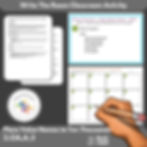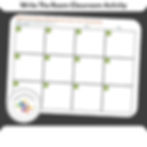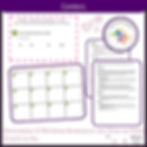Phonemic awareness and phonological awareness are essential for learning to read and spell. By teaching students to break words down into their sounds, they can better understand how to read and spell them.

This article will cover phonological awareness and its importance for success in reading, spelling, and writing. It will also describe 10 Individualized Education Plan goals that teachers can use to target this skill. Phonological awareness is a precursor to reading, spelling, and writing success, so teaching this skill is essential. In addition, phonological awareness can also predict academic success in general. Therefore, it is vital for teachers to know the different phonological awareness levels and how to target this skill with IEP goals. By doing so, they can help their students become successful readers, spellers, and writers.
What Is Phonological Awareness vs. Phonemic Awareness?
Phonemic awareness is the ability to hear, identify, and manipulate individual sounds (phonemes) in spoken words. Phonological awareness is a broader skill that includes phonemic awareness and encompasses the awareness of larger units of sound, such as rhyming and syllables.
Why Is Phonological Awareness Important?
Phonological awareness is important for special education teachers because it helps students with dyslexia and other reading difficulties. Phonemic awareness is the ability to hear, identify, and manipulate individual sounds (phonemes) in spoken words. Syllabication is the ability to divide spoken words into individual syllables. Phonemic awareness and syllabication skills are important for reading because they help students to break words down into smaller, more manageable parts.
Why Is Phonemic Awareness Important?

Phonemic awareness is important for special education teachers because it is the foundation for learning to read and spell. When students can hear and identify the individual sounds in words, they can better understand how to read and spell them. This is essential for students who are struggling with reading and spelling. In addition, phonemic awareness can also predict academic success in general. Therefore, it is necessary for special education teachers to be aware of the different phonemic awareness levels and know how to target this skill with IEP goals. By doing so, they can help their students become successful readers, spellers, and writers.
Phonemic awareness is important for special education teachers because it helps students with dyslexia and other reading difficulties. Dyslexia is a reading disability that is caused by a problem with phonemic awareness skills. Students with dyslexia have difficulty understanding that words are made up of individual sounds, and they often substitute one sound for another. For example, they might read the word "bat" as "cat."
Phonemic awareness is also important for teaching students to spell words correctly. To spell a word correctly, students need to be able to break the word down into its sounds. Phonemic awareness activities can help students learn how to spell words correctly.
Special education teachers can help their students develop phonemic awareness and syllabication skills by providing explicit instruction in these areas. They can also provide opportunities for students to practice these skills through various activities, including word games, rhyming activities, and sound segmentation exercises.
| If you're looking for a way to support your students' CVC word practice, look no further than these handy printables! They're perfect for struggling or new readers and writers, providing support for one-syllable words, decoding words, and letter sounds. Plus, they're easy to use - just print and go! With these printables, you'll have your students mastering CVC words in no time! |
3 Basic Levels of Phonological Awareness
There are different levels of phonological awareness, from simple to more complex:
Being able to hear and identify the individual sounds in words (phonemes)
For example, being able to break the word "cat" into /c/ /a/ /t/
Being able to identify rhyming words
For example, being able to identify that "cat" and "hat" rhyme
Being able to identify alliteration
For example, identifying that "Sally sells seashells by the seashore" contains alliteration.
What Are Some General Goals for Phonemic Awareness for All Students?
Increase the number of sounds the student can identify in spoken words.
Increase the student's ability to manipulate individual sounds in spoken words.
Increase the student's awareness of rhyming words.
Increase the student's awareness of syllables in spoken words.
Teach the student to blend sounds together to make words.
Teach the student to segment words into their individual sounds.
Teach the student to read CVC (consonant-vowel-consonant) words.
Teach the student to read CVCC (consonant-vowel-consonant-consonant) words.
Teach the student to read CCVC (consonant-vowel-consonant-vowel) words.
Teach the student to read CCVCC (consonant-vowel-consonant-vowel-consonant) words.
| More hand-picked content you may find helpful: |
|
10 Sample IEP Goals for Phonemic Awareness and Phonological Awareness
Here are ten creative IEP goals you can use for phonemic awareness and phonological awareness:
Main IEP goal with three measurable objectives
By (date), when given _________, the student will correctly identify initial, medial, and final sounds in words with 80% accuracy, as measured by _____.
Students see a picture and listen as the word is said aloud. Example words would include cub. Initial sound /c/, medial sound /u/, and final sound /b/. One of the biggest mistakes made when creating this goal is not tracking its individual parts.
To know your student's strengths and needs, teachers must break the goals down into manageable and measurable parts.
By (date), when given _________, the student will increase their phonemic awareness skills by 10% in the next 6 months, as measured by _____.
By (date), when given _________, the student will be able to blend individual sounds together to create a word with 80% accuracy, as measured by _____.
By (date), when given _________, the student will be able to segment words into individual sounds with 80% accuracy, as measured by _____.
By (date), when given _________, the student will be able to identify rhyming words with 80% accuracy, as measured by _____.
By (date), when given _________, the student will be able to identify words that begin with the same sound with 80% accuracy, as measured by _____.
By (date), when given _________, the student will be able to identify words that end with the same sound with 80% accuracy, as measured by _____.
By (date), when given _________, the student will be able to delete a sound from a word and still recognize the word with 80% accuracy, as measured by _____.
By (date), when given _________, the student will be able to add a sound to a word and still recognize the word with 80% accuracy, as measured by _____.
By (date), when given _________, the student will be able to change the order of letters in a word and still recognize the word with 80% accuracy, as measured by _____.
By setting goals like these, you can help students improve their phonemic awareness and phonological awareness skills.
10 More Sample IEP Goals for Phonemic Awareness and Phonological Awareness
Phonological iep goals should be specific, measurable, achievable, relevant, and time-bound.
1. By (date), when given _________, the student will be able to identify the number of syllables in 3 out of 5 spoken words, as measured by _____.
2. By (date), when given _________, the student will be able to identify initial, medial, and final sounds in 3 out of 5 spoken words, as measured by _____.
3. By (date), when given _________, the student will be able to blend individual sounds together to make 3 out of 5 spoken words, as measured by _____.
4. By (date), when given _________, the student will be able to segment 3 out of 5 spoken words into individual sounds, as measured by _____.
5. By (date), when given _________, the student will be able to read CVC words with 80% accuracy, as measured by _____.
6. By (date), when given _________, the student will be able to read CVCC words with 80% accuracy, as measured by _____.
7. By (date), when given _________, the student will be able to read CCVC words with 80% accuracy, as measured by _____.
8. By (date), when given _________, the student will be able to read CCVCC words with 80% accuracy, as measured by _____.
9. By (date), when given _________, the student will be able to read words with more than one syllable with 80% accuracy, as measured by _____.
10. By (date), when given _________, the student will be able to read contractions with 80% accuracy, as measured by _____.
By setting goals like these, you can help students improve their phonemic awareness and phonological awareness skills.
So, what do all of these goals have in common? They're all designed to help students improve their phonemic awareness and phonological awareness skills. These are essential skills for reading and spelling success. So, if you're looking for a way to help your students boost their literacy skills, consider setting some phonemic awareness goals!
If you're looking for a way to help your students boost their literacy skills, consider browsing our store for new and developing special education resources.
Thank you for reading! I hope this article has helped you learn more about phonemic awareness and phonological awareness skills, and how to set goals to help your students improve these skills. If you're looking for more information or resources, be sure to check out our other blogs and resources!
Sincerely,
TeachTastic IEP Team
































